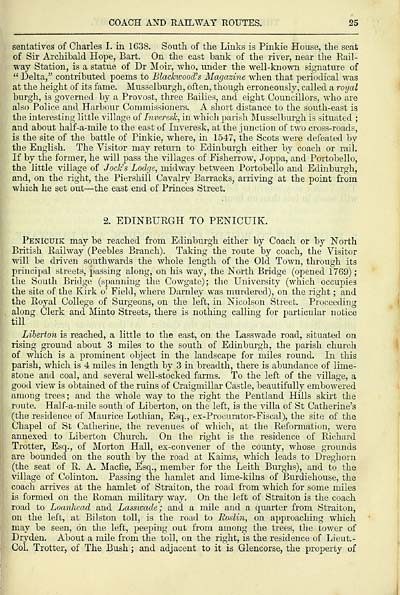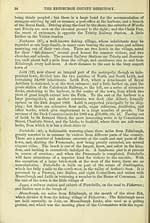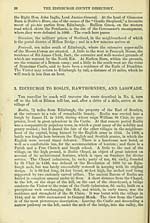Download files
Complete book:
Individual page:
Thumbnail gallery: Grid view | List view

COACH AND RAILWAY ROUTES. 25
sentatives of Charles I. in 1638. South of the Links is Pinkie House, the seat
of Sir Archibald Hope, Bart. On the east hank of the river, near the Rail-
way Station, is a statue of Dr Moir, who, under the well-known signature of
" Delta," contributed poems to Blackwood's Magazine when that periodical was
at the height of its fame. Musselburgh, often, though erroneously, called a royal
burgh, is governed by a Provost, three Bailies, and eight Councillors, who are
also Police and Harbour Commissioners. A short distance to the south-east is
the interesting little village of Inveresk, in which parish Musselburgh is situated ;
and about half-a-mile to the east of Inveresk, at the junction of two cross-roads,
is the site of the battle of Pinkie, where, hi 1547, the Scots were defeated by
the English. The Visitor may return to Edinburgh either by coach or rail.
If by the former, he will pass the villages of Fisherrow, Joppa, and Portobello,
the little village of Jock's Lodge, midway between Portobello and Edinburgh,
and, on the right, the Piershill Cavalry Barracks, arriving at the point from
which he set out — the east end of Princes Street.
2. EDINBURGH TO PENICUIK.
Penicuik may be reached from Edinburgh either by Coach or by North
British Railway (Peebles Branch). Taking the route by coach, the Visitor
will be driven southwards the whole length of the Old Town, through its
principal streets, passing along, on his way, the North Bridge (opened 1769) ;
the South Bridge (spanning the Cowgate); the University (which occupies
the site of the Kirk o' Field, where Darnley was murdered), on the right ; and
the Royal College of Surgeons, on the left, in Nicolson Street. Proceeding
along Clerk and Minto Streets, there is nothing calling for particular notice
till
Liberton is reached, a little to the east, on the Lasswade road, situated on
rising ground about 3 miles to the south of Edinburgh, the parish church
of which is a prominent object in the landscape for miles round. In this
parish, which is 4 miles in length by 3 in breadth, there is abundance of lime-
stone and coal, and several well-stocked farms. To the left of the village, a
good view is obtained of the ruins of Craigmillar Castle, beautifully embowered
among trees ; and the whole way to the right the Pentland Hills skirt the
route. Half-a-mile south of Liberton, on the left, is the villa of St Catherine's
(the residence of Maurice Lothian, Esq., ex- Procurator-Fiscal), the site of the
Chapel of St Catherine, the revenues of which, at the Reformation, were
annexed to Liberton Church. On the right is the residence of Richard
Trotter, Esq., of Morton Hall, ex-convener of the county, whose grounds
are bounded on the south by the road at Kaims, which leads to Dreghorn
(the seat of R. A. Macfie, Esq., member for the Leith Burghs), and to the
village of Colinton. Passing the hamlet and lime-kilns of Burdiehouse, the
coach arrives at the hamlet of Straiton, the road from which for some miles
is formed on the Roman military way. On the left of Straiton is the coach
road to Loanhead and Lasswade; and a mile and a quarter from Straiton,
on the left, at Bilston toll, is the road to Roslin, on approaching which
may be seen, on the left, peeping out from among the trees, the tower of
Dryden. About a mile from the toll, on the right, is the residence of Lieut. -
Col. Trotter, of The Bush ; and adjacent to it is Glencorse, the property of
sentatives of Charles I. in 1638. South of the Links is Pinkie House, the seat
of Sir Archibald Hope, Bart. On the east hank of the river, near the Rail-
way Station, is a statue of Dr Moir, who, under the well-known signature of
" Delta," contributed poems to Blackwood's Magazine when that periodical was
at the height of its fame. Musselburgh, often, though erroneously, called a royal
burgh, is governed by a Provost, three Bailies, and eight Councillors, who are
also Police and Harbour Commissioners. A short distance to the south-east is
the interesting little village of Inveresk, in which parish Musselburgh is situated ;
and about half-a-mile to the east of Inveresk, at the junction of two cross-roads,
is the site of the battle of Pinkie, where, hi 1547, the Scots were defeated by
the English. The Visitor may return to Edinburgh either by coach or rail.
If by the former, he will pass the villages of Fisherrow, Joppa, and Portobello,
the little village of Jock's Lodge, midway between Portobello and Edinburgh,
and, on the right, the Piershill Cavalry Barracks, arriving at the point from
which he set out — the east end of Princes Street.
2. EDINBURGH TO PENICUIK.
Penicuik may be reached from Edinburgh either by Coach or by North
British Railway (Peebles Branch). Taking the route by coach, the Visitor
will be driven southwards the whole length of the Old Town, through its
principal streets, passing along, on his way, the North Bridge (opened 1769) ;
the South Bridge (spanning the Cowgate); the University (which occupies
the site of the Kirk o' Field, where Darnley was murdered), on the right ; and
the Royal College of Surgeons, on the left, in Nicolson Street. Proceeding
along Clerk and Minto Streets, there is nothing calling for particular notice
till
Liberton is reached, a little to the east, on the Lasswade road, situated on
rising ground about 3 miles to the south of Edinburgh, the parish church
of which is a prominent object in the landscape for miles round. In this
parish, which is 4 miles in length by 3 in breadth, there is abundance of lime-
stone and coal, and several well-stocked farms. To the left of the village, a
good view is obtained of the ruins of Craigmillar Castle, beautifully embowered
among trees ; and the whole way to the right the Pentland Hills skirt the
route. Half-a-mile south of Liberton, on the left, is the villa of St Catherine's
(the residence of Maurice Lothian, Esq., ex- Procurator-Fiscal), the site of the
Chapel of St Catherine, the revenues of which, at the Reformation, were
annexed to Liberton Church. On the right is the residence of Richard
Trotter, Esq., of Morton Hall, ex-convener of the county, whose grounds
are bounded on the south by the road at Kaims, which leads to Dreghorn
(the seat of R. A. Macfie, Esq., member for the Leith Burghs), and to the
village of Colinton. Passing the hamlet and lime-kilns of Burdiehouse, the
coach arrives at the hamlet of Straiton, the road from which for some miles
is formed on the Roman military way. On the left of Straiton is the coach
road to Loanhead and Lasswade; and a mile and a quarter from Straiton,
on the left, at Bilston toll, is the road to Roslin, on approaching which
may be seen, on the left, peeping out from among the trees, the tower of
Dryden. About a mile from the toll, on the right, is the residence of Lieut. -
Col. Trotter, of The Bush ; and adjacent to it is Glencorse, the property of
Set display mode to: Large image | Transcription
Images and transcriptions on this page, including medium image downloads, may be used under the Creative Commons Attribution 4.0 International Licence unless otherwise stated. ![]()
| Scottish Post Office Directories > Counties > Midlothian (Edinburghshire) > Edinburgh county directory > (31) |
|---|
| Permanent URL | https://digital.nls.uk/85990507 |
|---|
| Description | Directories of individual Scottish counties or parts of counties. |
|---|
| Description | Around 700 Scottish directories published annually by the Post Office or private publishers between 1773 and 1911. Most of Scotland covered, with a focus on Edinburgh, Glasgow, Dundee and Aberdeen. Most volumes include a general directory (A-Z by surname), street directory (A-Z by street) and trade directory (A-Z by trade). |
|---|


